List of Contents
Automotive Interior Market Size and Forecast 2025 to 2034
The global automotive interior market size was calculated at USD 171.89 billion in 2024 and is predicted to increase from USD 181.68 billion in 2025 to approximately USD 310.44 billion by 2034, expanding at a CAGR of 6.13% from 2025 to 2034.
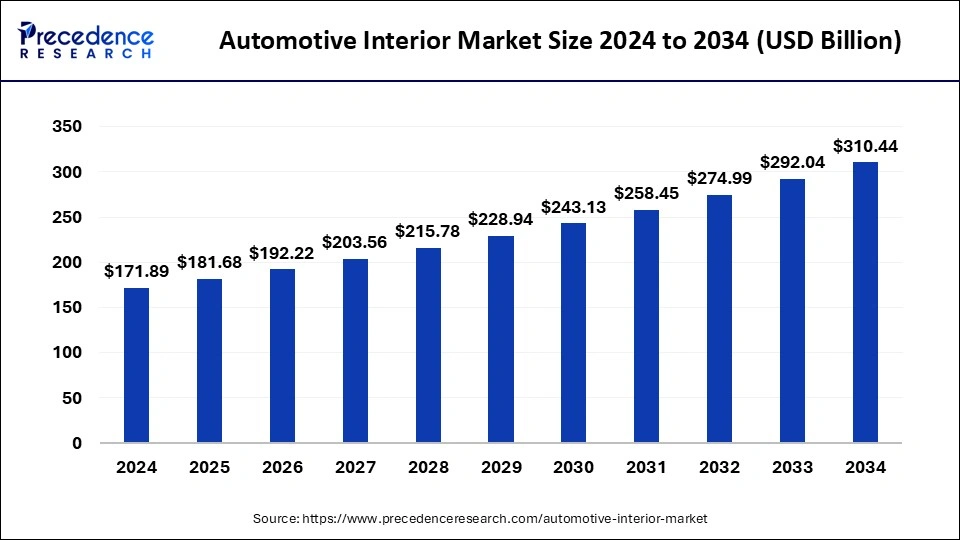
Automotive Interior Market Key Takeaways
- The global automotive interior market was valued at USD 171.89 billion in 2024.
- It is projected to reach USD 310.44 billion by 2034.
- The market is expected to grow at a CAGR of 6.13% from 2025 to 2034.
- Asia Pacific accounted for the highest market share of 32.30% in 2024.
- By component, the seating segment has generated market share of around 16.59% in 2024.
- By material, the composite segment has held market share of 25.06% in 2024.
- By vehicle type, the commercial segment has accounted for 46.30% of the total market share in 2024.
- By vehicle type, the passenger vehicle type segment has garnered market share of 53.70% in 2024.
AI integration in the Automotive Interior Market
The introduction of artificial intelligence into the automotive industry makes it possible to transform the interior market, introducing a smarter user experience. AI helps to improve interaction between the driver and passengers through voice control, gestures, and customization of the car settings. It customizes infotainment, climate, and seat settings according to user behaviour and makes it more comfortable and satisfying. Also, artificial intelligence can be used to facilitate autonomous navigation as the data provided by the sensors and the cameras is processed to provide the advanced capabilities of the vehicle. This transition brings about new opportunities in interior design, whose main focus will be on connectivity, comfort, and automation.
Asia Pacific Automotive Interior Market Size and Growth 2025 to 2034
The Asia Pacific automotive interior market was exhibited at USD 55.52 billion in 2024 and is projected to be worth around USD 103.88 billion by 2034, growing at a CAGR of 6.46% from 2025 to 2034.
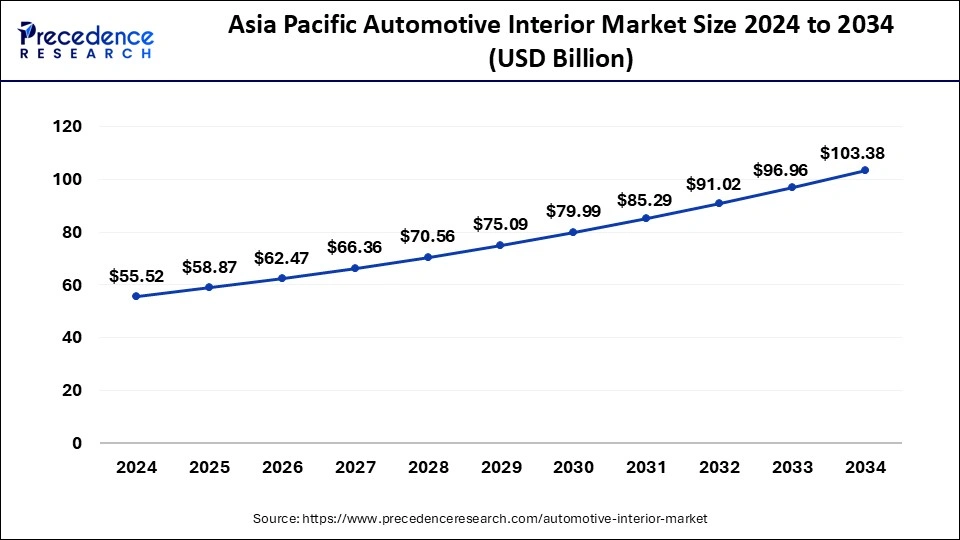
Asia Pacific dominated the global automotive interior market in 2024. It is also estimated to be the fastest-growing market during the forecast period. This is attributed to the growing demand for the comfort and luxury in the vehicles along with the rising production of automotive vehicles in the region. The availability of cheap factors of production and the favorable government policies have attracted the investments in the Asia Pacific region that made it the largest producer of the automotive vehicles. This increased the consumption of the automotive interiors in the Asia Pacific region. The popular automotive manufacturers like Toyota, Honda, Maruti, and Hyundai are contributing to the growth of the global automotive interior market.
- The North America automotive interior market size was valued at USD 52.08 billion in 2024 and is expected to hit around USD 97.17 billion by 2034, growing at a CAGR of 6.48% from 2025 to 2034.
- The Europe automotive interior market size was valued at USD 48.64 billion in 2024 and is projected to reach over USD 90.96 billion by 2034, poised to grow at a CAGR of 6.50% from 2025 to 2034.
- The LAMEA automotive interior market size was estimated at USD 12.36 billion in 2024 and is anticipated to reach around USD 14.77 billion by 2034, poised to grow at a CAGR of 1.77% from 2025 to 2034.
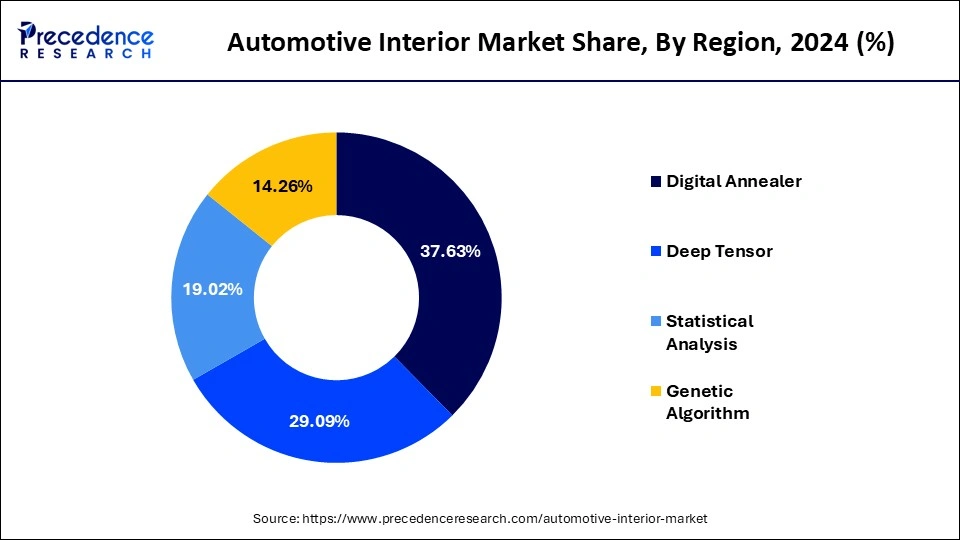
Asia Pacific
India Automotive Interior Market Trends
India's automotive interior market is expected to grow at a CAGR over the forecast period. The extreme increase in Decades and SUVs in the automotive industry in the country is fueling the need for high-quality interior materials. High consumer demand for comfort and luxury, especially among Gen Z buyers, growth in disposable incomes, and urbanization are driving the interest in using luxury interior designs and advanced features.
The Indians are focusing on the aesthetics, usability, and environmental friendliness of vehicle interiors, and automakers are using newer materials, including lightweight compositions, synthetics like faux leather in place of leather, and greener materials. In addition, the market is further driven by government incentives to local manufacturing, such as the Make in India projects, as well as the growth of electric vehicles.
Why is North America undergoing the Fastest Growth in the Automotive Interior Market?
North America is estimated to grow at the fastest CAGR during the forecast period. The existence of major auto makers with a strong provider network maintains constant creativity in interior designs, materials, and technology. The increasing consumer preference in high-end luxuries like ergonomic seats, luxury fabrics, modern technologies of infotainment with climate controls, and climatic measures is straining automakers to invest in high-end products and services.
Additionally, the orientation towards sustainability in the region, as well as stringent government policies related to emissions and the safety of vehicles, are proving beneficial towards the introduction of eco-friendly and recyclable materials in automobile interiors. Consumers in North America value comfort, customization, and connectivity, which prompts automakers to pursue the development of the interior features of their vehicles with smart applications, unique styling, and uninterrupted compatibility of digital systems.
The United States, being the largest contributor in the North American market, is helping in the automotive interior is experiencing growing demand in modernised and innovative interior designs. This also involves the incorporation of more advanced materials, such as the use of quality synthetic leather, lighter composite parts, soft touch materials, the use of large digital screens, as well as the incorporation of smart control systems. Moreover, competition through product launching, collaborating, and customization capabilities is creating innovations and adding customer experience.
- In October 2023, Asahi Kasei announced an investment in the U.S. startup NFW, which is focused on providing a non-petroleum-based leather alternative for automotive interiors. This partnership, which falls within Asahi Kasei's "Care for Earth" initiative, will offer globalization support to automakers addressing climate-related issues.
(Source: https://www.asahi-kasei.com)
What Are the Key Trends Driving the European Automotive Interior Market?
The European automotive interior market is expected to account for a substantial market share in 2024. European consumers prefer high-quality and luxury materials like natural leather, real wood decorations, and quality fabrics, which help in the demand for car interiors that not only look attractive but comfortable.
The area has some of the highest premium automobile corporations in the world, such as BMW, Mercedes, Audi, and Volvo, which are ever advancing the boundaries of interior ingenuity and designs. The increase in consumer demand to be equipped with intelligent and connected features also affects the adoption of smart infotainment systems, ambient lighting, and comfortable seats in the interior of a modern vehicle.
Germany is reported to be a major contributor to the automotive interior materials industry in Europe. Increasing demand rates of luxury and passenger cars in Germany are presenting new markets for interior materials innovation, particularly in response to changing customer desires toward comfort, technology, and safety.
The advantages of lightweight composites, vegan leather, and digitally integrating materials have been propelled by technological advancements and by the desire of people to have luxurious and customized interiors. Germany is the automotive innovation leader in Europe and is at the center of the development of interior materials in the region.
- In April 2023, Marelli presented their latest product innovations at Auto Shanghai 2023, with a focus on co-creating the future of mobility. Marelli's electromechanical actuator, which they call full active electromechanics technology, diminishes roll, pitch, yaw, and vibration from the self-generated reactive force and actual sound damping located within the vehicle.
(Source: https://www.marelli.com)
Automotive Interior MarketGrowth Factors
The surging demand for the private vehicles, rising standard of living of the consumers, rising disposable income, growing demand for luxurious vehicles, and growing popularity of the electric vehicles across the globe are some of the major factors that drives the growth of the global automotive interior market. The rising safety concerns coupled with the technological advancements is spurring the demand for the advanced automotive interiors. The growing demand for the light weigh commercial vehicles for the transportation of goods is fueling the market growth. The adoption of smart lighting systems, advanced seating systems, and rising investments in the development of comfortable and convenient interiors are significantly boosting the growth of the global automotive interior market.
The adoption of the lightweight materials to offer innovative looks and finishing to the automotive interiors is a prominent driving factor. The government regulations pertaining to the carbon emissions, safety, and energy efficiency is resulting in the increased investments on the adoption of lightweight and innovative materials to reduce the weight of the vehicles that would increase energy efficiency is playing a crucial role in the market growth. Around 5% to 7% of the fuel can be saved by implementing a weight reduction of 10% of a vehicle. Moreover, the easy availability and suitability of plastics like polyvinyl chloride and acrylonitrile butadiene styrene is encouraging the OEMs to manufacture lightweight interior components for the various type of automotive vehicles. Moreover, the low costs and characteristicsof these plastics favors the adoption of the plastic materials in the manufacturing of interiors and offers cost-effectiveness to the OEMs. Thus, the adoption of lightweight materials is expected to drive the growth of the automotive interior market during the forecast period.
The autonomous and the semi-autonomous vehicles are gaining rapid traction in the market. The technological advancements in the automotive industry favored the adoption of digital technologies in the automotive interiors. The growing demand for the autonomous vehicles across the globe is expected to foster the growth of the global automotive interior market. The innovative designs and latest technologies in the autonomous vehicles boosting the growth of the cockpit electronic systems in the automotive vehicles. Therefore, the rising demand for the autonomous vehicles across the globe is fostering the growth of the automotive interior market.
Market Scope
| Report Highlights | Details |
| Market Size by 2034 | USD 310.44 Billion |
| Market Size in 2025 | USD 181.68 Billion |
| Growth Rate | CAGR of 6.13% from 2025 to 2034 |
| Largest Market | Asia Pacific |
| Fastest Growing Market | North America |
| Base Year | 2024 |
| Forecast Period | 2025 to 2034 |
| Segments Covered | Component,Vehicle, Material, Region |
| Regions Covered | North America, Europe, Asia-Pacific, Latin America, and Middle East & Africa |
Market Dynamics
Drivers
Changing Regulatory Landscape Coupled with Reduction in Vehicle Weight
The automotive interior market is growing considerably due to the changing regulations and industry controlling approach of reducing in weight of vehicles. Fuel efficiency and reduction of toxic emissions are one of the major objectives of the automotive industry. The automakers are turning to the use of lightweight materials like newly developed plastics, composites, and technical fabrics in vehicle interiors. These materials trim down the weight of trucks and vehicles, and they also assist in their ability to meet the strict regulatory requirements.
Environmental regulations, such as in the Corporate Average Fuel Economy (CAFE) policies in the U.S and other parts of the world, are forcing automakers into fuel-saving strategies. Consequently, there is an increase in the demand for lightweight inside parts- dashboards, seat structure, door panels, and trim. These elements help in enhancing vehicle performance, increasing mileage, and even less environmental influence.
Rapidly Expanding E-Vehicle Market
The escalating trend of the electric vehicle (EV) use around the world, due to the compelling necessity to quit the use of fossil fuels, is having a solid impact on the automotive interior market. Those manufacturing EVs are turning more towards the use of lightweight materials, including sophisticated plastics, composites, and technical fabrics, to enhance the level of energy efficiency and help increase vehicle range. By use of these materials, the overall weight of the vehicle would be reduced, enhancing the battery performance as well as lessening the recharge time. Governments all over the globe are also in the process of promoting the use of EVs by coming up with attractive policies, subsidies, and incentives. This is policy support, and it is speeding up the manufacturing of EVs and subsequently resulting in a high demand for new and lightweight automotive interior materials.
Restraint
High Cost of Advanced Technologies and Fluctuating Raw Material Prices
The high cost of incorporating complex technologies, including infotainment systems, touch and interactive displays, advanced safety features, and control panels, is also identified as one of the key thresholds in the automotive interior materials market. Moreover, the raw materials like plastics, leather, fabrics, and other metals required in the automotive interior industry are quite expensive and prone to price changes because of global supply chain shocks, geopolitical issues, and movement in commodity prices. Such fluctuations may have a great effect on the cost of production and cut the profit margin of automakers and suppliers. Raw material costs are unpredictable, and therefore, long-term planning and pricing strategies are difficult.
Opportunity
Rising Adoption of Bioplastics
The automotive sector is experiencing increasing popularity in using bioplastics, especially in interior performance, due to the changing trend towards sustainability in the automotive sector. As conventionally applied in vehicle interiors, plastics have enjoyed the advantage of being very lightweight, flexible, and affordable, besides providing a direct way of increasing fuel efficiency by reducing vehicle weight. But as more people are becoming more environmentally conscious, and as the fossil fuel-based resources are becoming exhaustible, automakers have now resorted to bio-based plastics as an alternative that is more conducive to the environment. Established automakers promote the use of vegan leather seats and trims to reduce the need for the increasingly large number of consumers wanting to find cruelty-free and renewable solutions.
Component Insights
Based on the component, the seat segment dominated the global automotive interior market in 2024. The growing vehicle production owing to a rise in the demand for the private andcommercial vehicles coupled with the rising demand for the luxury, comfort, and convenience has exponentially driven the growth of this segment. Seat is an essential part of any vehicle and is the most important component with which the maximum comfort is associated with. Therefore, the primary focus of the manufacturers is to produce a comfortable seat. Therefore the development of adjustable seats, customizable comfort, and various other features has supplemented the growth of this segment in the forecast period.
On the other hand, rear seat entertainment is expected to be the most opportunistic segment during the forecast period. The increased demand for listening to online music while travelling is propelling the growth of this segment. The technological advancements and the entertainment in automotive vehicles have gained a rapid traction in the past few years and is expected to grow at a promising rate during the forecast period.
Vehicle Type Insights
Based on the vehicle type, the passenger vehicles segment dominated the global automotive interior market in 2024. The increased number of passenger vehicles across the globe owing to the rise in disposable income, rising standards of living, and increased demand for the personal luxury vehicles across the globe has augmented the growth of the passenger vehicles segment. Moreover, the rising adoption of electric vehicles and autonomous vehicles is further expected to drive the growth of this segment in the forthcoming years.
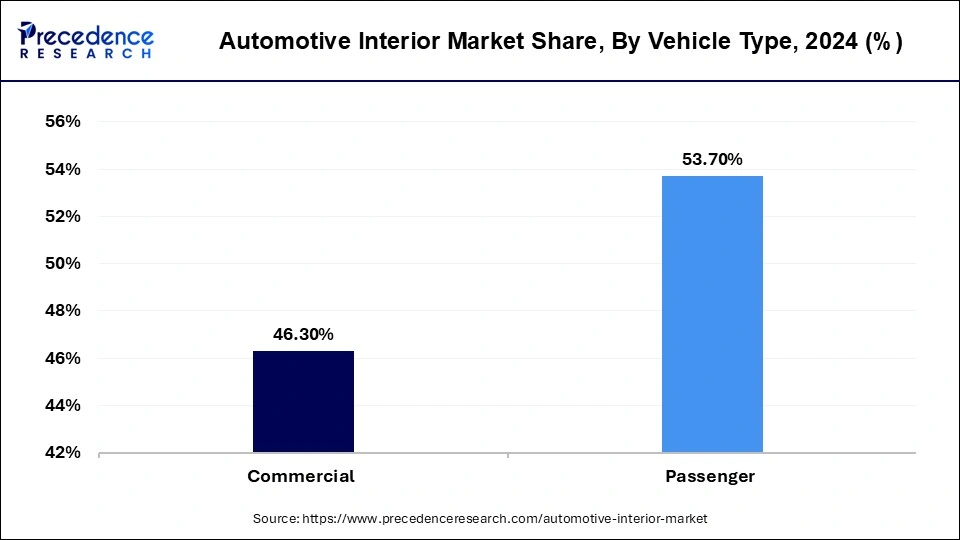
The commercial vehicles segment is estimated to be the fastest-growing segment during the forecast period, owing to the rising economic activities across the globe. The growing investments for the industrial development has resulted in the rise in economic activities. The increased demand for the enhanced distribution systems, the demand for the lightweight commercial vehicles and heavy weight commercial vehicles is on the rise. Thus this segment is anticipated to witness a significant growth rate.
Automotive Interior Market Revenue, By Vehicle Type, 2022 to 2024 (USD Billion)
| By Vehicle Type | 2022 | 2023 | 2024 |
| Commercial | 71.13 | 75.20 | 79.58 |
| Passenger | 83.16 | 87.57 | 92.30 |
Material Insights
Based on the material, the glass fiber composite segment accounted for the largest share of the global automotive interior market in 2024. It is used in the production of wider variety of interior components in the automotive. Glass fiber composite is used for making components such as headliners, dashboards, insulation, and doors. The glass fiber composites offers several benefits like low cost, high impact resistance, and lightweight, which makes it an idle choice for making automotive interiors.
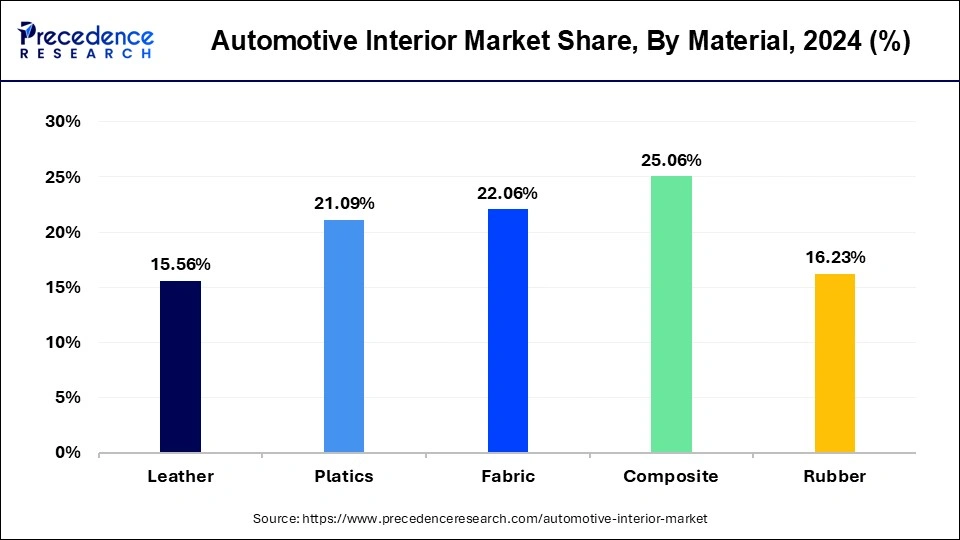
Fabric is estimated to be the most opportunistic segment. The fabric materials are attractive and comfortable. Fabrics are versatile and has durability which makes it a popular choice for the automotive interiors. For instance, the wool can be woven into any texture and it has increased applications in the seats that is expected to drive the growth of this segment during the forecast period.
Automotive Interior Market Revenue, By Material, 2022 to 2024 (USD Billion)
| By Material | 2022 | 2023 | 2024 |
| Leather | 23.94 | 25.29 | 26.75 |
| Plastics | 32.45 | 34.28 | 36.25 |
| Fabric | 33.97 | 35.87 | 37.92 |
| Composite | 38.60 | 40.76 | 43.07 |
| Rubber | 154.28 | 26.56 | 27.90 |
Automotive Interior Market Companies
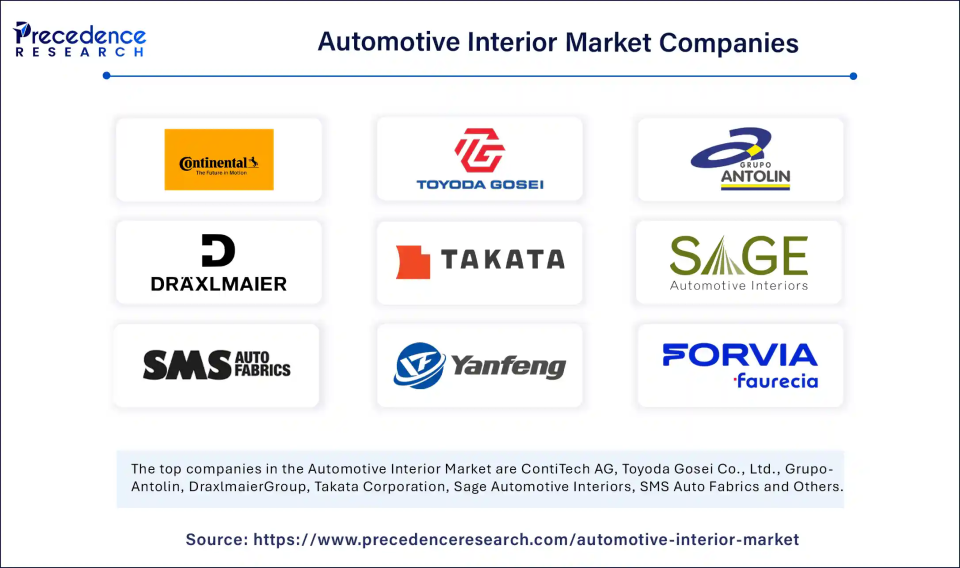
- ContiTech AG
- Toyoda Gosei Co., Ltd.
- GrupoAntolin
- DraxlmaierGroup
- Takata Corporation
- Sage Automotive Interiors
- SMS Auto Fabrics
- Yanfeng Automotive Interiors
- LEAR Corporation
- Faurecia S.A.
- Magna International
- Calsonic KenseiCorporation
- Tachi-S Co. Ltd.
- Hyundai Mobis Co. Ltd.
- TATA Group
Recent Developments
- In September 2024, Toyoda Gosei Co., Ltd. introduced an innovative system that allows automotive developers to perceive variations in vehicle interior sounds with various combinations of sealing components (weatherstrips) installed on those vehicles, ultimately enhancing quietness in the vehicle cabin and creating more comfortable spaces on the move.
- In July 2024, Antolin announced a joint project with MIT ADT University regarding the projects they would undertake on automotive interior design. In this partnership, they would share the knowledge of both organizations to create fresh solutions for vehicle interiors. This demonstrates Antolin's focus on pushing the boundaries of automotive interior design and innovation.
- In May 2024, Yanfeng and Trinseo announced a partnership to accelerate their efforts to develop circular materials for automotive interiors. The partnership entails to creation of materials for 2030 End-of-life vehicle compliance and the development of circular materials.
Segments Covered in the Report
By Component
- Heads Up Display
- Headliner
- Center Stack
- Seat
- Instrument Cluster
- Door Panel
- Interior Lighting
- Dome Module
- Adhesives & Tapes
- Rear Seat Entertainment
- Others
By Vehicle Type
- Passenger
- Commercial
By Material
- Leather
- Vinyl
- Wood
- Fabric
- Metal
- Glass Fiber Composite
- Carbon Fiber Composite
By Geography
- North America
- U.S.
- Canada
- Europe
- U.K.
- Germany
- France
- Asia Pacific
- China
- India
- Japan
- South Korea
- Latin America
- Brazil
- Rest of Latin America
- Middle East & Africa (MEA)
- GCC
- North Africa
- South Africa
- Rest of the Middle East & Africa
For inquiries regarding discounts, bulk purchases, or customization requests, please contact us at sales@precedenceresearch.com
Frequently Asked Questions
Ask For Sample
No cookie-cutter, only authentic analysis – take the 1st step to become a Precedence Research client